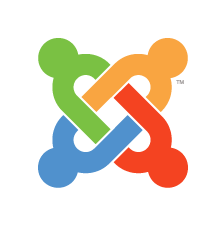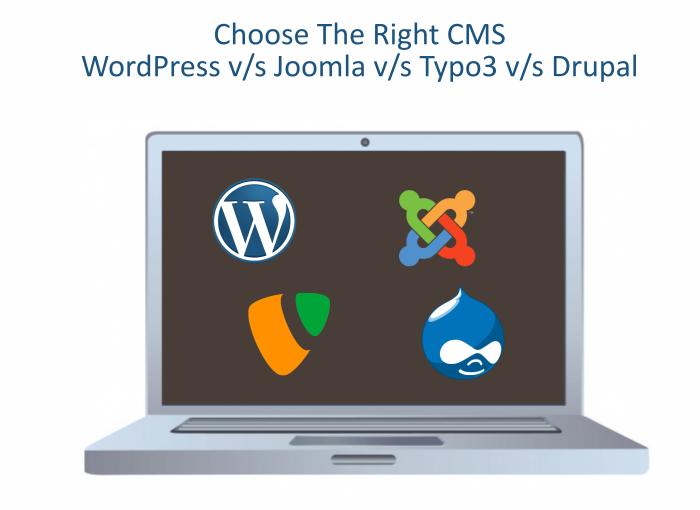Content Management Systems have succeeded in becoming one of the most powerful web developers tools since PHP. Today, more and more web developers will be found trending towards open source CMS platforms to get their job done. Unfortunately, there are thousands of CMS’s floating around the web and finding the right one seems to be incredibly tricky. The following post explores a comparative study on the four major CMS platforms:
- WordPress
- Joomla
- Typo3
- Drupal
CMS Comparison: TYPO3 vs. Drupal vs. Joomla! vs. WordPress
| Features | Typo3 | Drupal | Joomla | WordPress |
| Website | typo3.com | drupal.org | joomla.com | wordpress.org |
| Available since | 2000 | 2001 | 2005 | 2003 |
| Open Source license | GNU General Public License | |||
| Programming language | PHP | |||
| Available In Number of languages | 50 | 181 | > 60 | 50 |
| Used for | Medium-sized & large companies, esp. international organizations | Medium-sized & large companies | Small companies | Small companies and blogs |
| Strengths | Stability, localization, feature-rich, investment security | Barrier-free for editors | Interfaces, single-site installation | Blog functionality, configurable for editors |
| Plugins/Market Place | Yes | |||
| Weakness | Steep learning curve for developers | Steep learning curve for developers | Poor feature set for international websites | Vulnerable for security issues |
 WordPress :
WordPress :
WordPress was introduced as a pure weblog system which can be easily converted to a Web Content Management System, of course with considerable effort.
Highlights/ Advantages/ Disadvantages
- System Requirements: WordPress is actually based on PHP and requires MYSQL database to work effectively. If we talk about the system requirements, it needs few storage and hardware resources and is therefore suited for rapid creation of extensive blogs dealing with a wide range of topics. Like any other blog system, WordPress differentiates between two display areas:
- Articles are listed either by topic category or displayed according to the time of publication.
- Every article can be commented upon by users, only if the feature has been enabled web server the blog or website operator.
- Extensions: Next, the blog system included in WordPress is quite similar to Typo3, a basic system featuring extensions that can be enabled as needed. The basic package provided by most of the prominent WordPress development companies is only limited number of plugins while all others must be manually installed after initial installation. Although, there are numerous plugins available but most of them cover features from the community-based social software or web 2.0 spectrum.
- Limited enterprise capability: WordPress 3.5 supports two of the most important features of an enterprise web CMS, i.e. Multilanguage and Multidomain capabilities. It may quite interest you to know that for this purpose, the features of formerly separate MU version were integrated into the CMS as standard. And this is the reason why it is possible to operate several blog domains with one WordPress installation.
- Security problems: Due to enormous popularity as well as regular security gaps, several automated attacks have been targeted at WordPress. As a result, WordPress developers are striving hard to increase security.
Joomla
Another important web content management system worth considering is Joomla. With its origins in the open source project Mambo, Joomla turns out to be entirely object-oriented and components adhere to the Model View Controller (MVC) design principles. By using Joomla as a framework and its corresponding API, one can easily end up creating extensions and web applications using the framework. The new Joomla User Interface (JUI) library allows a user to individually customize extensions. Thus, it is used to subsequently implement additional enterprise features such as SAP connectors or similar features.
Highlights/ Advantages/ Disadvantages
- System requirements: Like WordPress, Joomla is based on PHP and MYSQL. The basic requirement for a successful operation on a webserver is PHP 5.3.1. Moreover, Joomla 3.x supports the databases MSSQL and PostgreSQL pretty easily.
- Easy installation: System installation is very simple and can be carried out within minutes. Hence, even small to medium sized companies without IT departments can implement an operational web CMS. For example, many fora websites choose Joomla as a CMS platform to cover all important questions and topics, and users can quickly find information regarding the system.
- Security issues: Due to the popularity of the CMS, many hack attacks have been made on Joomla sites! Due to an insufficient input check, developers soon found a security gap. However, since the release of version 1.5.6, security gaps have reduced to third-party plugins.
- Extensions: Joomla being a large community offers a wide range of extensions. For example, in the backend or frontend, specific additional features are included such as RSS feed integration. On and all, components, modules, and plugins are interconnected in such a way that they do not function individually and need to be installed as a package to achieve desirable results.
 Typo3
Typo3
Unlike other open sources available in the market, most of the web development companies believe Typo3 as one of the mature, feature-complete enterprise web content management system. In fact, the platform offers connections to numerous third-party systems that are already present in the existing software architecture.
Highlights/ Advantages/ Disadvantages
Fortunately, Typo3 fulfills almost all the requirements that companies place on a license-free content management system. Starting from supporting global websites through Multilanguage- and localization features to connect to nay software system, comprehensive system for user authorization and access, the platform offers an endless number of possibilities such as:
- Extensive Multilanguage functions and localization options
- Enterprise Digital Asset Management for the administration of extensive datasets
- Abstraction layer for integration into numerous third-party systems and databases
- Secure areas for intranet/extranet
- On-the-fly generation of graphical menus
- Web-based image processing (cropping, scaling, converting, effects)
- Complete design freedom even with flash through the unique template
- Rich text editor
- Complete user access management with granular rights and workflow processes
- Intelligent extension framework for API-based development of extensions and features
- AJAX-based backend with user-friendly “drag and drop” functions
 Drupal
Drupal
Unlike Joomla or Typo3 which are pure-play web content management systems or WordPress which are often used as a blog software, Drupal follows the approach of combining simple web content management with social community software. In addition to this, Drupal strongly focuses on providing an extensive set of social community tools.
Highlights/ Advantages/ Disadvantages
- Distributions: Drupal is used by numerous companies as a community tool for social portals and blogs. For this, numerous distribution models are available such as stand-alone blog distribution, community distribution, distribution for educational institutions, etc.
- System Requirements: The current version is Drupal 7.x which can be effortlessly implemented either on an Apache-, Ngix-, Lighttpd- or Microsoft ISS-Server. Either MySQL from version 5.0.15 on, PostgreSQL from Version 8.3 or SQLite from version 3.3.7 can be used as database server software. Since version 7, PHP 5.2 is also used.
- Extensions and exchangeable: Like other CMS, additional features are implemented through the use of extensions. However, these modules are not compatible with other Drupal versions. In short, Drupal is unsuitable for use in a business-critical corporate environment and its maintenance turns out to be a full-time job.
- CMS and framework: Drupal is comprehensive and well documented but it is not based on a standard CMS architecture visualized for developers. Hence, it cannot be used as web CMS but it can be used as a comprehensive social community solution.

